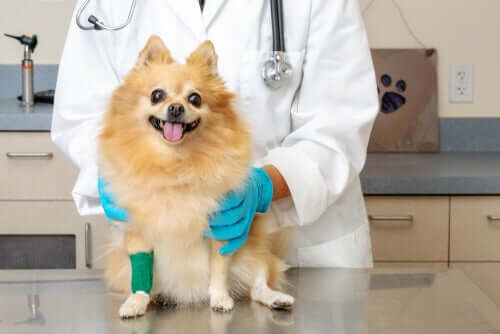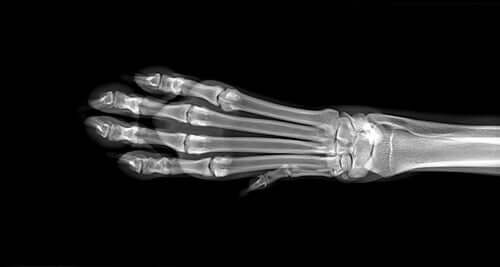Swollen Legs in Dogs: Causes and Symptoms

Swollen legs in dogs can be the sign of a simple injury or a chronic disease. If you pay attention to the associated symptoms, you should be able to identify what’s causing your pet’s discomfort.
There are many factors that can cause swollen legs in dogs. First, we’ll take a look at how it has developed, the number of affected areas, and the type of inflammation. Localized pain or the presence of internal fluid are two of the most common reasons for discomfort. However, they’re at opposite ends of the spectrum in terms of severity.
As a result, the best choice is to go and see your vet.
Causes and symptoms
Regardless of the root cause, pain and heat are common symptoms. This increase in body temperature can lead to a fever which doesn’t have to be related to more serious conditions.
A few things that can lead to swelling are:
- Arthritis. As well as pain and heat, redness and lameness are usually very common. This is particularly common in the joints of older dogs, although it can happen if your dog has a genetic predisposition.
- Sprains. This could be the result of a specific injury or continuous physical strain. Big dogs are more prone to this and may well start limping.

- Hypertrophic osteodystrophy. This bone disease affects the puppies of large breeds as they develop. It’s usually very painful, can affect more than one leg, and is accompanied by a fever. If you don’t treat it properly with anti-inflammatories, good hygiene, and rest, it can get much more serious.
- Hygroma. This normally a non-painful sack of fluid that forms in the dog’s joints. It usually appears as a result of excessive pressure caused by the way they sit or lie down. It’s important to treat this so as to prevent infection.
- Osteosarcoma. This bone cancer is one of the most fatal diseases and mainly affects large dogs. As the disease progresses, the inflammation, pain, and localized heat all get worse.
Treating swollen legs in dogs
First, your vet will carry out a series of diagnostic tests to identify the cause of the swelling. These will include blood and urine tests and possible x-rays of the limbs. If these tests don’t throw up anything conclusive, they may want to take an MRI scan. If they suspect that it’s osteosarcoma, they’ll perform a bone biopsy.

For less serious conditions, your vet will probably recommend anti-inflammatories, rest, and maybe physiotherapy. If your dog has a sack of fluid in their joints, the vet may choose to remove it surgically. As for cases of cancer, besides chemotherapy, the most common treatment is amputation.
Preventing swollen legs in dogs may not always be possible. However, if it’s a case of arthritis, it’s important to try to keep your dog at a healthy weight and make sure they get plenty of exercise.
But don’t overdo it. Too much physical activity is just as bad as none at all. Try to also avoid bad posture and avoid hard beds to reduce the chances of hygromas.
Ultimately, the best way to avoid these problems is to ensure that your dog maintains a healthy lifestyle and has regular check-ups with the vet. Then, if they do develop a problem, they’ll get the treatment they need as soon as possible.
All cited sources were thoroughly reviewed by our team to ensure their quality, reliability, currency, and validity. The bibliography of this article was considered reliable and of academic or scientific accuracy.
- Harness, J. (2018). Cuteness. How to Take Care of a Dog’s Swollen Leg. Recuperado de https://www.cuteness.com/article/care-dogs-swollen-leg
- Wagwalking. Legs Swollen and Hot in Dogs. (S f). Recuperado de https://wagwalking.com/symptom/why-is-my-dog-legs-swollen-and-hot
